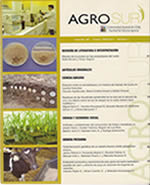Propiedades físicas de suelo posterior al cambio de uso de bosque nativo a viña
Contenido principal del artículo
Resumen
En Chile, debido a que los suelos ubicados en los valles se encuentran cultivados, las laderas con vegetación nativa han sido utilizadas por la agricultura. En el Valle de Apalta, Santa Cruz, VI Región de Chile, se midieron algunas propiedades físicas de suelo tanto en la entre hilera (IR) como en la hilera de plantación (R) en una viña cultivada en una ladera (7 años desde su establecimiento, 8% de pendiente), comparando los resultados con las propiedades de suelo de un sitio con vegetación nativa (N). Con este propósito, se midió la conductividad hidráulica en superficie y algunas propiedades físicas (densidad aparente, distribución de tamaño de poros, resistencia tensil, estabilidad de agregados y flujo de aire) y materia orgánica en tres profundidades (0-10, 10-30, 30-50 cm). En el horizonte superficial, el cambio de uso de suelo generó diferencias significativas con respecto al sitio N, disminuyendo el contenido de carbono orgánico, la porosidad gruesa (>50 μm) y la estabilidad de agregados, e incrementando la densidad aparente y la resistencia tensil. La perturbación física del suelo promovió un deterioro en la funcionalidad de este, disminuyendo la capacidad de flujo de agua y aire. Las mayores diferencias fueron encontradas en la superficie del sitio IR, mientras que en profundidad (50 cm) los cambios no fueron significativos entre los sitios, por lo que se concluye que aún persisten las condiciones de suelo previo a su cultivo.

